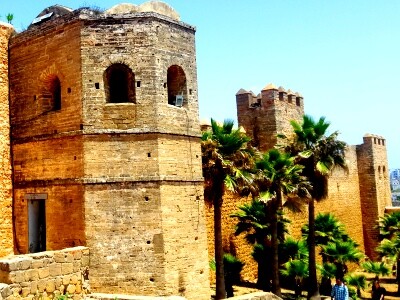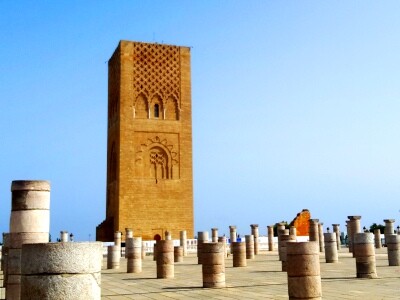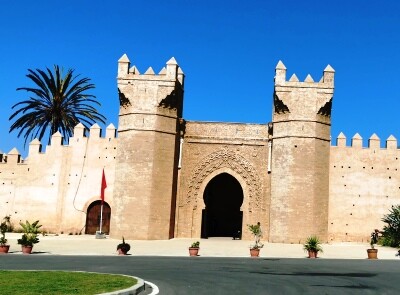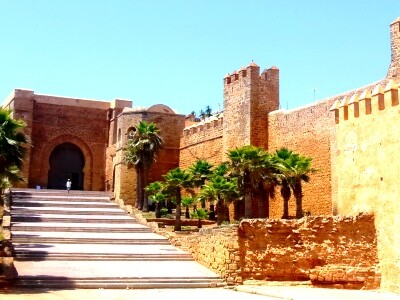As Morocco’s capital and seat of government, Rabat’s influence is matched only by that of the country’s financial center, Casablanca. It has the feel of a grand imperial city, with a fascinating historic center filled with splendid sultans’ palaces, inspiring mosques, and centuries – old ramparts. These are complemented by neat modern buildings housing political offices, foreign embassies, and university faculties.
Rabat lies on the country’s Atlantic coast at the mouth of the Bou Regreg River, 225 km south of the Strait of Gibraltar. Its twin city of Salé, now in effect a suburb of Rabat, sits on the opposite bank of the river. Rabat enjoys a mild climate of warm summers and slightly cooler winters, making it a popular destination for both city breaks and longer vacations. Typically, temperatures reach around 28 ° C in summer and 18 ° C in winter, although evenings tend to be on the chilly side whatever the time of year. Spring and autumn are the most comfortable times to visit. The pace of life seems slower in Rabat than in many Moroccan cities, despite the fact that Rabat and Salé together make up one of the most densely populated areas of the country. Things are certainly much less fast – paced than in bustling Casablanca, just along the coast. This leisurely approach to life hasn’t always been the case, however. Rabat has a long history of invasions and endured a spectacular period in the 17th century when pirates ruled not only the city but also the seas around its coast. Modern Rabat has plenty to offer visitors, from the chance to relax in neatly tended gardens and the medina (which is considerably less chaotic and intense than those of Morocco’s other imperial cities) to the opportunity to spend time in the Marché Central, with its heady smell of spices, and enjoy a meal in one of the numerous cafés lining the broad tree – filled
avenues of the French – built ville nouvelle (new town). The must – sees are the Oudayas Kasbah, perched strategically above the estuary, with its celebrated 12th-century gate and mosque, the brilliant – white Mausoleum of Mohamed V, and the unfinished mosque and minaret of the 12th – century sultan Yacoub el Mansour. Rabat is also famed for its great medieval ramparts, which still dominate the skyline, winding for 5 km around the kasbah medina, and new town. They are punctuated by five great, ornamental gates known as Babs. To the south of Rabat’s center is the Chellah Necropolis, on the site where the city began. The weed – strewn ruins lie in marked contrast to the gleaming facades of the city’s Royal Pal ace and government and commercial buildings. Rabat can easily be explored in a few days, Its history may, however, take longer to digest Be sure to visit some of its museums, which are among the best in the country. The Musée Archéologique provides a fascinating overview of Morocco’s ancient past and holds numerous examples of statues, ceramics, and bronze implements recovered from the Roman settlements of Volubilis, Lixus, and Sala Colonia (modern – day Rabat). The Musée des Oudayas, meanwhile, housed in the Oudayas Kasbah, is dedicated to the Moroccan arts with displays of ceramics, jewelry, musical instruments, and traditional costumes.
CENTRAL RABAT: Rabat is a bustling metropolis of government buildings, offices of major financial and commercial companies, and elegant modern hotels that sit among centuries – old souks, aged kasbahs, and ramparts with imposing gates decorated with arabesque floral motifs. It is a thrilling mix of contemporary and ancient architecture, and the new and the old are more integrated and interwoven than in most Moroccan cities.

The Oudayas Kasbah, with its mighty honey – colored ramparts and watchtowers dominating the skyline, occupies the city’s northern tip on the banks of the Oued Bou Regreg. The kasbah is named for the Oudaya, an Arab tribe that settled on the Atlantic coast in the 17th century and played a key role in defending the city from Spanish invaders during the reign of Sultan Moulay Ismail. Oudayas Kasbah differs from examples found elsewhere in Morocco in that it is not simply a fortress or a palace, but a small, heavily fortified town – a medina

No visitor to Rabat can pass up a trip to the Hassan Tower , which had it ever been completed, would have formed part of one of the world’s greatest mosques. The 12th-century ruler Sultan Yacoub el Mansour, founder of the Almohad dynasty, wanted to build a mosque so magnificent it would go down in history. He saw Rabat as the center of his empire and wanted a mosque that was befitting of its state of grandeur and consequence. The mosque was designed by the Moroccan architect Jabir, who also designed the Koutoubia Mosque in Marrakech. It was to be built to a rectangular shape and would have incorporated a huge prayer room with a series of columns topped with capitals. Its minaret would have stood some 260 feet (86 m) high, making it the tallest in the world. However, the sultan died in 1199 and construction stopped with just a couple hundred columns having been completed; The minaret stood little more than half its intended height. Still standing, the unfinished square minaret and marble column stumps are a spectacular sight. Made of red sand stone, the minaret is highly decorated with a fretwork of arches. It overlooks the Oued Boregrag river and, although not open to the public, it is – along with the nearby Mausoleum of Mohamed V – one of the most visited landmarks in the city. The tower is currently being considered for UNESCO World Heritage site status.










BASIC INFORMATION ABOUT DATA PROTECTION FROM FINEST MOROCCO TOUR
Responsible: FINEST MOROCCO TOUR. Purposes: Respond to your requests and send commercial information about our services. Legitimation: Consent of the interested party. Recipient: The transfer of data to third parties is not foreseen, except legal obligation. Rights: You can withdraw your consent at any time, as well as access, rectify, delete your data and other rights at info.fmtour1@gmail.com. Additional Information: You can expand the information in the following link: “PRIVACY POLICY”.